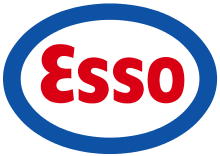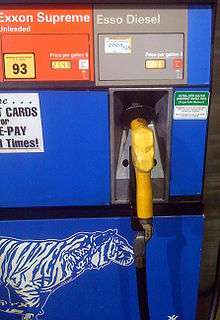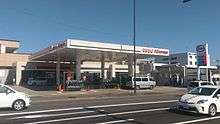Esso
 | |
| Founded | 1912 |
|---|---|
| Headquarters | Irving, Texas, U.S. |
Key people | Evelyn Victor Yoganathan, Nicholas Alexander Wallace Ross |
| Products | Oil, Fuel |
| Parent | ExxonMobil |
| Website |
www |
Esso /ˈɛsoʊ/ is a trading name for ExxonMobil and its related companies. The name is an acronym for Eastern States Standard Oil,[1] a post-Standard Oil-breakup company that started as Standard Oil of New Jersey, and as it acquired other Standard Oil-heritage companies, they shortened it in 1932.[2] As such, the name was also a play on the initials of Standard Oil - SO = Esso. In 1972, it was largely replaced in the U.S. by the Exxon brand after it bought Humble Oil, while Esso remained widely used elsewhere.
In most of the world, the Esso brand and the Mobil brand are the primary brand names of ExxonMobil, with the Exxon brand name still in use only in the United States alongside Mobil.


History
In 1911, Standard Oil was broken up into 34 companies, some of which were named "Standard Oil" and had the rights to that brand in certain states (the other companies had no territorial rights). Standard Oil Company (New Jersey) ("Jersey Standard") had the rights in that state, plus in Maryland, West Virginia, Virginia, North Carolina, South Carolina, and the District of Columbia. By 1941, it had also acquired the rights in Pennsylvania, Delaware, Arkansas, Tennessee, and Louisiana. In those states, it marketed its products under the brand "Esso", the acronym for "Eastern States Standard Oil".
It also used the Esso brand in New York and the six New England states, where the Standard Oil Company of New York (Socony-Vacuum, later Socony Mobil) had the rights, but did not object to the New Jersey company's use of the trademark (the two companies did not merge until November 1999). However, in the other states, the other Standard Oil companies objected and, via a 1937 U.S. federal court injunction, forced Jersey Standard to use other brand names.[3] In most states the company used the trademark Enco ("Energy Company"), and in a few "Humble".
The other Standard companies likewise were "Standard" or some variant on that in their home states, and another brand name in other states. Esso ranked 31st among United States corporations in the value of World War II production contracts.[4]
During the years of racial segregation in the United States, certain Esso franchises gave out The Negro Motorist Green Book: An International Travel Guide.[5] In 1973, Standard Oil of New Jersey renamed itself as the Exxon Corporation, and adopted that trademark throughout the country. It maintained the rights to "Standard" and "Esso" in the states where it held those rights, by a token effort, by selling "Esso Diesel" in those states at stations that sell diesel fuel, thus preventing the trademark from being declared abandoned.
It retained the "Esso" brand in Puerto Rico and the United States Virgin Islands until 2008, when it sold its stations there to Total S.A.[6]
The Enco brand name was used on locations in the Midwest until 1977 when they were sold to Cheker Oil Co. (now part of Marathon Petroleum subsidiary Speedway LLC[7]); Exxon continues to have a presence in southern Ohio today (as it does throughout much of Appalachia in general), though Mobil is the company's primary brand in the Midwest.
In February 2016, ExxonMobil successfully asked a U.S. federal court to lift the 1930s trademark injunction that banned it from using the Esso brand in certain states. By this time, as a result of numerous mergers and rebranding, the remaining Standard Oil companies that previously objected to the Esso name had been acquired by BP.
ExxonMobil cited trademark surveys in which there was no longer possible confusion with the Esso name as it was more than seven decades before. BP also had no objection to lift the ban.[3]
ExxonMobil did not specify whether they would now open new stations in the U.S. under the Esso name; they were primarily concerned about the additional expenses of having separate marketing, letterheads, packaging, and other materials that omit "Esso".[8]
United Kingdom
_001.jpg)
In 1888, the Anglo American Oil Company opened its head office in London, which eventually became a part of Esso.[9] In August 1998, Tesco announced a partnership with Esso, opening chains of Tesco Express stores located within forecourts, which continues today.[10] In February 2000, the two companies were opening one new store a month, creating 4,000 jobs.[11]

Esso Blue
Esso Blue was the brand name of Esso's paraffin oil (kerosene) for domestic heaters in countries such as the United Kingdom. Their television advertising song from the 1950s, through to the 1970s, was the famous "Bom, Bom, Bom, Bom, Esso Blue!"
One campaign used the well-known song tune of "Smoke Gets in Your Eyes" reworded as:[12] "They asked me how I knew, it was Esso Blue, I of course replied, with lower grades one buys, smoke gets in your eyes. The non-smoking paraffin". The track was released as a flexi disk which was given away free in hardware stores.[13]
Cleveland
In the 1930s, Esso acquired Cleveland, an independent company based in North East England. The name comes from the fact that the founder and principal shareholder, Norman Davis, spent some of World War I with his brother Manuel in Cleveland, Ohio. Cleveland's products included a benzole blend and an alcohol blend called "Discol". The Esso and Cleveland names continued in use until 1973, when the Cleveland filling stations were re-branded as Esso.
Northern Ireland
Esso traded in Northern Ireland up until the early 2000s. Their forecourts were re-branded as Maxol and some remained private.
Euro Garages
45 of Euro Garages' forecourts were bought from Esso in 2013, and are operated under the Esso brand. They plan to roll out partner brands such as Starbucks and Spar, replacing the Esso branded shops.
Shop and Drive
Shop and Drive is an Esso branded convenience store operated in some stations, although many of their locations have franchised shops such as Nisa.
Affiliates
Canada

In Canada, the Esso brand is used on stations operated by Imperial Oil, which is 69.8% owned by ExxonMobil. Esso also provides aviation fuel services at 80 airport locations in Canada (Aviation and Avitat).
Australia
In Australia, Esso is an affiliate of ExxonMobil, it operates oil and gas production. Its retail petrol stations were acquired by Mobil Australia in 1990.
Japan

Established as Esso Standard Oil (Japan) in 1962 with Standard Vacuum division in Japan. It became Esso Oil in 1982. After the Exxon and Mobil merger in 1999, the Japanese subsidiaries were reorganized as ExxonMobil Y.K. in 2002, later renamed to EMG Marketing in 2012 and acquired as a subsidiary by TonenGeneral Oil in the same year. In 2016 JX Holdings and the TonenGeneral Group merged into JXTG Holdings, leading to the dissolution and absorption of EMG Marketing into a subsidiary of the new company, JXTG Nippon Oil & Energy, in 2017.[14] As a result, ExxonMobil's Esso and Mobil brands are planned to be migrated to JX's ENEOS brand in 2019.[15]
Branding
Esso is ExxonMobil's primary gasoline brand worldwide except in Australia, Guam, Mexico (starting in about the first quarter of 2018), Nigeria and New Zealand, where the Mobil brand is used exclusively. In Canada (since 2017), Colombia, Egypt, Japan (until 2020) and formerly Malaysia, both the Esso and Mobil brands are used. While Esso and Mobil in Malaysia were rebranded as Petron in 2013, Esso and Mobil in Japan will be rebranded as ENEOS in 2020, since the acquisition of Esso and Mobil from JXTG Nippon Oil & Energy in 2017.
Mobil is ExxonMobil's primary retail gasoline brand in California, Florida, New York, New England, the Great Lakes and the Midwest. Exxon is the primary brand in the rest of the United States, with the highest concentration of retail outlets located in New Jersey, Pennsylvania, Texas and in the Mid-Atlantic and Southeastern states.
Advertising campaigns
In the 1960s, campaigns featuring heavy spending in different mass media channels became more prominent. Esso spent hundreds of millions of dollars on a brand awareness campaign built around the simple and alliterative[16] theme Put a Tiger in Your Tank.[17] Psychologist Ernest Dichter[18] and DDB Worldwide copywriter Sandy Sulcer[19] learned that motorists desired both power and play while driving, and chose the tiger as an easy to remember symbol to communicate those feelings.
The North American and later European campaign featured extensive television and radio and magazine ads, including photos with tiger tails supposedly emerging from car gas tanks, in England there were faux tiger tails with pink ribbons to tie round underneath the cap of the petrol tank so as to look as if there was a tiger in the tank: these were often seen on the road in the 1960s; at one time in England there was a television advertisement where a sombre man labelled as the advertising manager said that they were no longer going to have the tiger, followed a short while later with advertisements for the save the tiger campaign, promotional events featuring real tigers, billboards, and in Europe station pump hoses "wrapped in tiger stripes" as well as pop music songs.[17] Tiger imagery can still be seen on the pumps of successor firm ExxonMobil.
Commercial automotive and motorcycle partnerships
Esso, along with its sister brands Exxon and Mobil, are official long-term recommended gasoline of Porsche, Bentley, Toyota, Lexus, Daihatsu, Hino, Chevrolet (including Corvette), Cadillac, Opel, Vauxhall, Buick, Holden, Mercedes-Benz (until 2015, now fully switched to Petronas in 2016) and Perodua for automobiles and also Honda for both automobiles and motorcycles.
References
- ↑ Citation needed
- ↑ Falola, Toyin (30 Sep 2005). The Politics of the Global Oil Industry: An Introduction. Westport, CT: Praeger. p. 27. ISBN 978-0275984007.
- 1 2 "The Return of Esso Gasoline?". CSP Daily News. February 16, 2016. Retrieved September 18, 2016.
- ↑ Peck, Merton J. & Scherer, Frederic M. The Weapons Acquisition Process: An Economic Analysis (1962) Harvard Business School p.619
- ↑ McGee, Celia (August 22, 2010). "The Open Road Wasn't Quite Open to All". The New York Times. Retrieved April 25, 2011.
Although Victor Green’s initial edition only encompassed metropolitan New York, the Green Book soon expanded.... The 15,000 copies Green eventually printed each year were sold as a marketing tool not just to black-owned businesses but to the white marketplace, implying that it made good economic sense to take advantage of the growing affluence and mobility of African Americans. Esso stations, unusual in franchising to African Americans, were a popular place to pick one up.
- ↑ Lett, Christine (March 11, 2008). "Total Petroleum to take over Esso's fuel business in V.I." The Virgin Islands Daily News. Archived from the original on March 13, 2008. Retrieved June 11, 2010.
- ↑ "Archived copy" (PDF). Archived from the original (PDF) on September 17, 2011. Retrieved November 29, 2012.
- ↑ "After 78 Years, Exxon Asks Court To Use 'Esso' Name Again". CSP Daily News. December 21, 2015. Retrieved September 18, 2016.
- ↑ "Our early days in Europe". About us. Exxon Mobil Corporation. Retrieved January 17, 2014.
- ↑ "Esso fuels Tesco's expansion". news.bbc.co.uk. August 21, 1998. Retrieved August 11, 2015.
- ↑ "Tesco link with Esso to create 4,000 jobs". theguardian.com. February 5, 2000. Retrieved August 11, 2015.
- ↑ the great blue singer — Esso Blue flexi disk recording, Juzp, archived from the original on 2013-02-21
- ↑ "The Great Blue Singer " at Discogs
- ↑ https://www.noe.jxtg-group.co.jp/english/company/history/tg.html
- ↑ "JXTG、2019年度中に「ENEOS」にブランドを統一 「エッソ/モービル/ゼネラル」は廃止" (in Japanese).
- ↑ William Safire (February 6, 2005). "ON LANGUAGE: Metaphor Madness". The New York Times. Retrieved October 19, 2011.
The foolish fearsomeness of this act was vitiated in the 1960s by Esso, which took a smiling tiger as a symbol with the alliterative slogan Put a tiger in your tank.
- 1 2 "Western Europe: The Tiger Goes Abroad". Time. May 28, 1965. Retrieved October 19, 2011.
"Put a tiger in your tank." The star of one of the most popular advertising campaigns ever hatched on Madison Avenue, Esso's frisky, whimsical tiger with the high-octane tail has become a roaring success all over Europe.
- ↑ Lynne ames (August 2, 1998). "The View From/Peekskill; Tending the Flame of a Motivator". The New York Times. Retrieved October 19, 2011.
Among his most famous successes was the slogan Put a tiger in your tank, still in use by Exxon.
- ↑ David Kaplan (January 23, 2004). "Sulcer, 77, Former DDB Needham Exec, Dies". adweek. Retrieved January 20, 2014.
Frederick D. "Sandy" Sulcer... He created the well-known "Put a tiger in your tank" theme line for Esso (now ExxonMobil)
External links
| Wikimedia Commons has media related to Esso. |